Study on Emergency Decision-Making of Mine External Fires Based on Deduction of Precursory Scenarios
Abstract
1. Introduction
2. Methods
2.1. Analysis of Precursors
2.2. Evolution Path of Fire Scenarios
2.3. Dynamic Bayesian Networks
2.4. Emergency Decision-Making Plans
2.4.1. Multi-Attribute Emergency Decision-Making Methods
2.4.2. Evaluation Indicator System
2.4.3. The Entropy Weight Method
2.4.4. The Improved TOPSIS Method
3. Results and Discussion
3.1. Case Study
3.1.1. Scenario Evolution Path
3.1.2. Calculation of Scenario Node Probabilities
3.1.3. Determination of Weights for Evaluation Criteria
3.1.4. TOPSIS Method
3.2. Discussion
4. Conclusions
- The accident evolution process is decomposed into three critical components: scenario states (S), emergency activities (A), and precursory elements (E). By analyzing these elements, a scenario evolution law is established, enabling the visualization of fire accident scenarios outside coal mines.
- This study constructs an initial Bayesian network structure to serve as a foundation for subsequent analysis. Utilizing dynamic Bayesian network methodologies, we calculate the probabilities of accidents and predict their potential future trajectories. Furthermore, we employ the Netica to facilitate the quantitative computation of scenario probabilities, culminating in the development of an emergency decision-making model.
- We employ the entropy weight method and an improved TOPSIS method for the quantification and weighting of emergency decision-making schemes. The establishment of a three-tiered emergency decision-making evaluation index system enhances the targeted nature of emergency decision-making. This contributes to the efficiency and accuracy of responses to external coal mine fires and expands the application of scenario deduction theory within the domain of coal mine fire accidents.
Author Contributions
Funding
Data Availability Statement
Conflicts of Interest
References
- Yuan, L. Theory and technology considerations on high-quality development of coal main energy security in China. Bull. Chin. Acad. Sci. 2023, 38, 11–22. (In Chinese) [Google Scholar] [CrossRef]
- Peisen, Z.; Xiaole, Z.; Yuhang, D. Law analysis and prediction research of coal mine accidents in China from 2008 to 2021. Min. Saf. Environ. Prot. 2023, 50, 136–140. [Google Scholar] [CrossRef]
- Lei, Y.S.; Xin, L. Study on Multi-Indicator Quantitative Risk Evaluation Methods for Different Periods of Coal Spontaneous Combustion in Coal Mines. Combust. Sci. Technol. 2024, 196, 1628–1641. [Google Scholar]
- Wang, K.; Huang, H.; Deng, J.; Zhang, Y.; Wang, Q. A spatio-temporal temperature prediction model for coal spontaneous combustion based on back propagation neural network. Energy 2024, 294, 130824. [Google Scholar] [CrossRef]
- Biao, K.; Zenghua, L.; Yongliang, Y.; Zhen, L.; Daocheng, Y. A review on the mechanism, risk evaluation, and prevention of coal spontaneous combustion in China. Environ. Sci. Pollut. Res. 2017, 24, 23453–23470. [Google Scholar]
- Muduli, L.; Jana, P.K.; Mishra, D.P. Wireless sensor network based fire monitoring in underground coal mines: A fuzzy logic approach. Process Saf. Environ. Prot. 2018, 113, 435–447. [Google Scholar] [CrossRef]
- Chao, H.; Shibin, N.; Zegong, L.; Song, L.; Hong, Z.; Jiayi, L.; Haoran, Z.; Zihan, W. A novel biomass sodium alginate gel foam to inhibit the spontaneous combustion of coal. Fuel 2022, 314, 122779. [Google Scholar]
- Xiaoxue, X.; Shujie, Y.; Jinhu, L.; Shengli, G.; Zhuo, Y. Preparation of lignin-based intumescent nanogel and its mechanism of inhibiting coal spontaneous combustion. Energy 2023, 275, 127513. [Google Scholar]
- Zhian, H.; Sainan, Q.; Xiangming, H.; Yinghua, Z.; Yukun, G.; Yucheng, J.; Xuyao, Q.; Yichao, Y. An Environmentally Friendly Antioxidant Foamed Gel for Inhibiting Spontaneous Combustion of Coal. Combust. Sci. Technol. 2023, 195, 4144–4165. [Google Scholar]
- Barros-Daza, M.J.; Luxbacher, K.D.; Lattimer, B.Y.; Hodges, J.L. Fire Size and Response Time Predictions in Underground Coal Mines Using Neural Networks. Min. Metall. Explor. 2022, 39, 1087–1098. [Google Scholar] [CrossRef]
- Geng, J.; Sun, Q.; Zhang, Y.; Gong, W.; Du, S. Non-destructive testing and temperature distribution of coal mine roadway lining structure under exogenous fire. J. Loss Prev. Process Ind. 2018, 55, 144–151. [Google Scholar] [CrossRef]
- Wang, K.; Jiang, S.; Ma, X.; Wu, Z.; Shao, H.; Zhang, W.; Cui, C. Information fusion of plume control and personnel escape during the emergency rescue of external-caused fire in a coal mine. Process Saf. Environ. Prot. 2016, 103, 46–59. [Google Scholar] [CrossRef]
- Selçuk, A.; Fatih, Y.; Ebru, G. Evaluation of the Quality of Safety and Health Services with SERVPERF and Multi-Attribute Decision-Making Methods. Int. J. Occup. Saf. Ergon. JOSE 2021, 28, 2216–2226. [Google Scholar]
- Qu, J.; Zhang, J.; Li, X.; Lu, B.; Hu, B.; Hu, N.; Zhu, X. Deduction of leakage accident scenarios of oil pipelines based on Bayesian network. China Saf. Sci. J. 2021, 31, 192–198. [Google Scholar] [CrossRef]
- Wang, Z.; Kong, W.; Fang, D.; Duan, Z. Research on urban flood and waterlog emergency scenario deduction based on Bayesian network. China Saf. Sci. J. 2021, 31, 182–188. [Google Scholar] [CrossRef]
- Changfeng, Y.; Yichao, H.; Yulong, Z.; Tao, Z.; Jiahui, W.; Shuangjiao, F. Evaluation on consequences prediction of fire accident in emergency processes for oil-gas storage and transportation by scenario deduction. J. Loss Prev. Process Ind. 2021, 72, 104570. [Google Scholar]
- Xiaoliang, X.; Yuzhang, T.; Guo, W. Deduction of sudden rainstorm scenarios: Integrating decision makers’ emotions, dynamic Bayesian network and DS evidence theory. Nat. Hazards 2022, 116, 2935–2955. [Google Scholar]
- Jinfeng, Z.; Mei, J.; Chengpeng, W.; Zhijie, D.; Xiaohong, W. A Bayesian network-based model for risk modeling and scenario deduction of collision accidents of inland intelligent ships. Reliab. Eng. Syst. Saf. 2024, 243, 109816. [Google Scholar]
- Zifu, F.; Yiyu, T.; Lang, L.; Xiaoyu, W. Reserch on the Evaluation and Decision of Emergency Plan of Network Public Opinion Emergencies Under Uncertain Environment. Math. Pract. Theory 2019, 49, 9–17. [Google Scholar]
- Zuqing, C.; Xun, J. Emergency Decision-making Generation and Optimization Based on Intelligence Process Optimization. Inf. Stud. Theory Appl. 2018, 41, 133–138. [Google Scholar] [CrossRef]
- Zhixia, Z.; Mengle, X. Decision-making of emergency response plan for natural gas pipeline emergency based on cloud model. Fire Sci. Technol. 2019, 38. 288–291+298. [Google Scholar]
- Baode, L.; Jing, L.; Yuan, J.; Hanwen, F.; Jing, L. A dynamic emergency response decision-making method considering the scenario evolution of maritime emergencies. Comput. Ind. Eng. 2023, 182, 109438. [Google Scholar]
- Pingping, W.; Jiahua, C. A Large Group Emergency Decision Making Method Considering Scenarios and Unknown Attribute Weights. Symmetry 2023, 15, 223. [Google Scholar] [CrossRef]
- Tiemin, L. Scenario Construction in Major Catastrophes: Theories and Methods. Fudan Public Adm. Rev. 2013, 46–59. [Google Scholar]
- Yongming, W. Conceptual model on scenario construction for major accidents. J. Saf. Sci. Technol. 2016, 12, 5–8. [Google Scholar]
- Wilson, I. From Scenario Thinking to Strategic Action. Technol. Forecast. Soc. Chang. 2000, 65, 23–29. [Google Scholar] [CrossRef]
- Cui, L.; Zhong, Q.; Ruan, J. Research on implementation process integration of multi-emergencies based on knowledge element. ICIC Express Lett. 2014, 8, 381–388. [Google Scholar]
- Li, X.; Peng, S.; Du, J. Towards medical knowmetrics: Representing and computing medical knowledge using semantic predications as the knowledge unit and the uncertainty as the knowledge context. Scientometrics 2021, 126, 6225–6251. [Google Scholar] [CrossRef]
- Yongcun, R.; Ren, Z. Scenario Expression Model of Zhengzhou Rainstorm Subway Disaster Event Based on Knowledge Element Theory. In Proceedings of the 10th Annual Meeting of Risk Analysis Council of China Association for Disaster Prevention (RAC 2022), Beijing, China, 18 July 2023. [Google Scholar]
- Jixin, Z.; Minghao, S.; Xiaosong, L.; Qiuju, Y.; Yilin, J.; Dongyang, H.; Haoyuan, D.; Jian, K. Dynamic risk evaluation of hydrogen station leakage based on fuzzy dynamic Bayesian network. Int. J. Hydrogen Energy 2024, 50, 1131–1145. [Google Scholar]
- Jinyue, C.; Long, D.; Jie, J.; Jiping, Z. A Combined Method to Build Bayesian Network for Fire Risk Assessment of Historical Buildings. Fire Technol. 2023, 59, 3525–3563. [Google Scholar]
- Sara, R.; Emel, A. A Multi-Attribute Decision Support System for Allocation of Humanitarian Cluster Resources Based on Decision Makers’ Perspective. Sustainability 2022, 14, 13423. [Google Scholar] [CrossRef]
- Baode, L.; Jing, L.; Jing, L.; Xuebin, Z.; Chuan, H.; Wan, S. Scenario evolutionary analysis for maritime emergencies using an ensemble belief rule base. Reliab. Eng. Syst. Saf. 2022, 225, 108627. [Google Scholar]
- Jianting, Y.; Boling, Z.; Dongdong, W.; Dachen, L.; Ruipeng, T. Risk coupling analysis under accident scenario evolution: A methodological construct and application. Risk Anal. Off. Publ. Soc. Risk Anal. 2023, 44, 1482–1497. [Google Scholar]
- Qiao, Y.; Gao, X.; Ma, L.; Chen, D. Dynamic human error risk assessment of group decision-making in extreme cooperative scenario. Reliab. Eng. Syst. Saf. 2024, 249, 110194. [Google Scholar] [CrossRef]
- Hongbo, J.; Menglin, Q.; Xinyu, W.; Dingding, L.; Huiting, O.; Yuting, L. Spatiotemporal evolution and driving factors of ecosystem service bundle based on multi-scenario simulation in Beibu Gulf urban agglomeration, China. Environ. Monit. Assess. 2024, 196, 542. [Google Scholar]
- Undheim, T.A. In search of better methods for the longitudinal assessment of tech-derived X-risks: How five leading scenario planning efforts can help. Technol. Soc. 2024, 77, 102505. [Google Scholar] [CrossRef]
- Federica, R.; Ming, Y.; Genserik, R.; Valerio, C. Emergency response in cascading scenarios triggered by natural events. Reliab. Eng. Syst. Saf. 2024, 243, 109820. [Google Scholar]
- Reynaldo, M.-S.L.; Angélica, L.; Esteban, O.-V.A. Determination of disaster scenarios for estimating relief demand to develop an early response to an earthquake disaster in urban areas of developing countries. Int. J. Disaster Risk Reduct. 2023, 87, 103570. [Google Scholar]
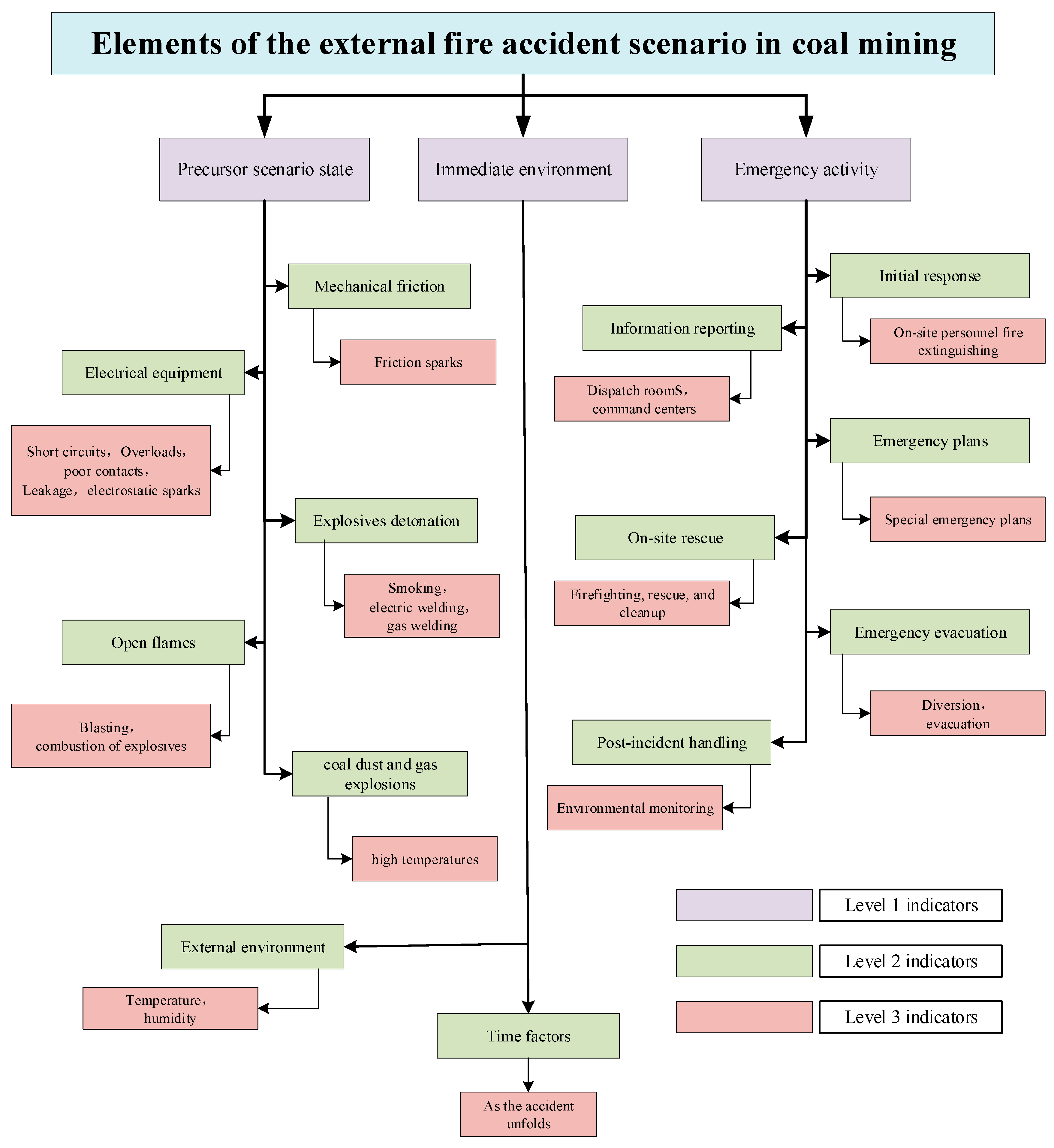
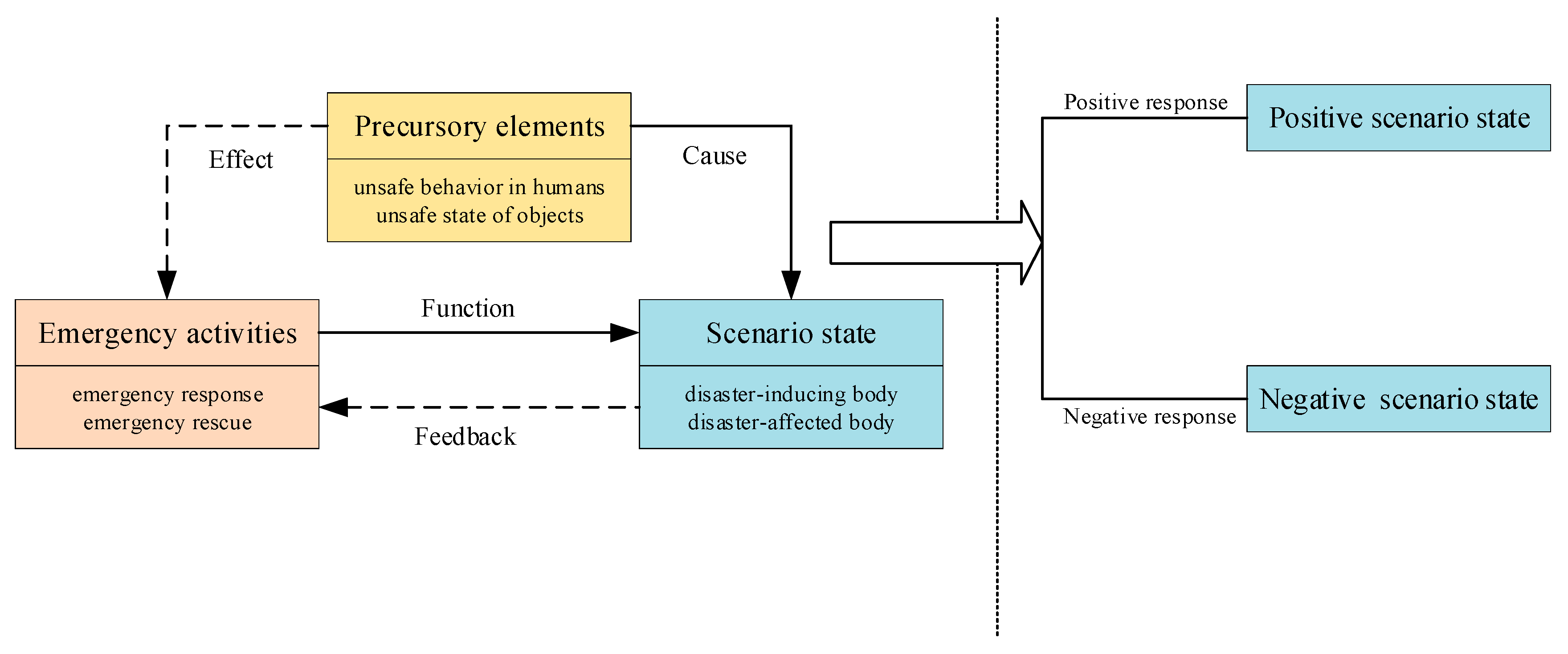

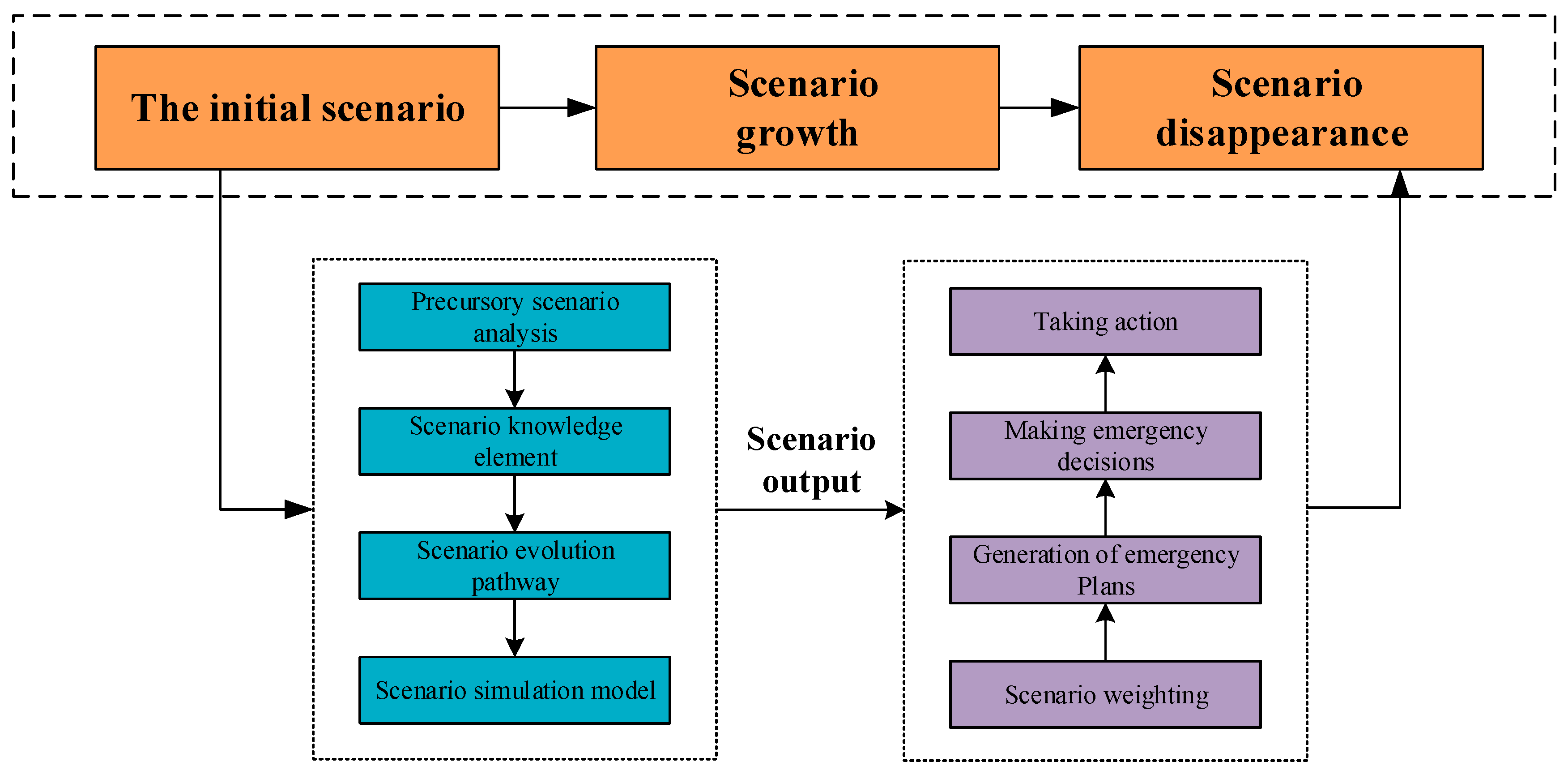
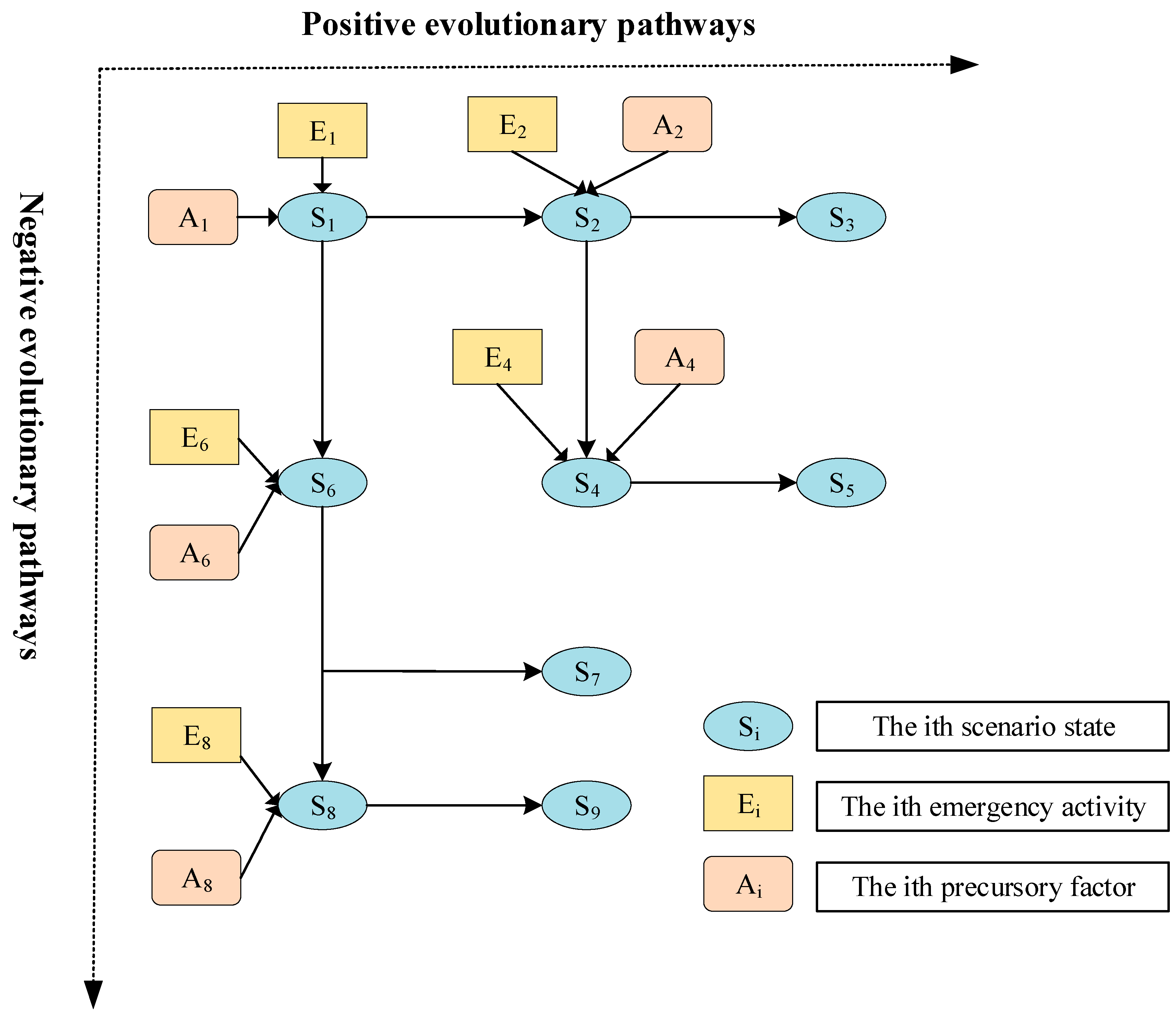
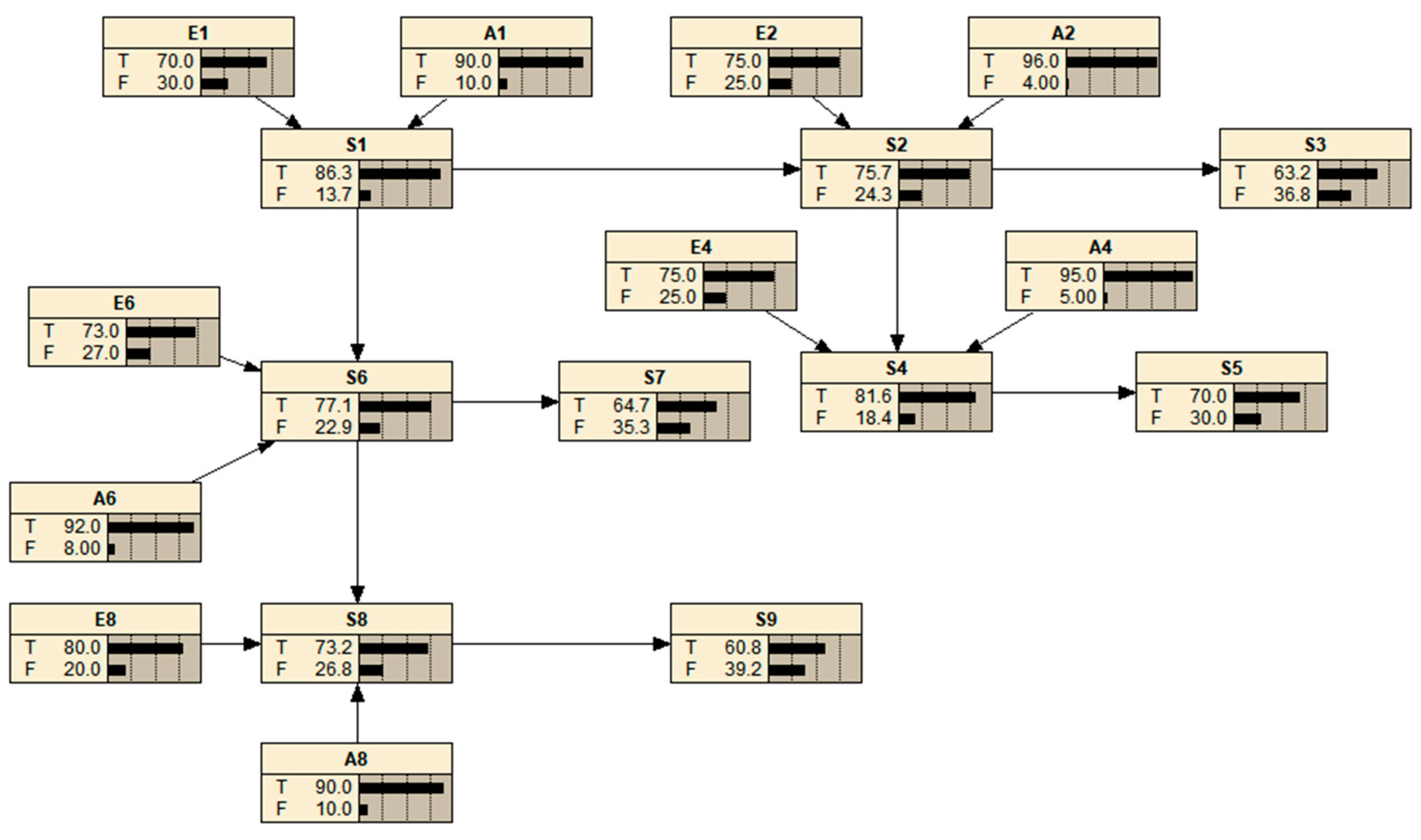
| Precursory Scenario | Numbers | Scale |
|---|---|---|
| Spontaneous combustion | 8 | 9.09% |
| Electrical cable fire | 11 | 12.50% |
| Cable short circuit | 11 | 12.50% |
| Distribution board overload and sparking | 1 | 1.14% |
| Coal electric drill short circuit and sparking | 2 | 2.27% |
| Overloaded cable ignition | 1 | 1.14% |
| Air compressor malfunction | 8 | 9.09% |
| Transformer fire | 2 | 2.27% |
| Unauthorized blasting | 3 | 3.41% |
| Arson | 1 | 1.14% |
| Spontaneous ignition of explosives | 2 | 2.27% |
| Workers carrying open flames | 2 | 2.27% |
| Open flames for heating | 1 | 1.14% |
| Conveyor belt ignition | 2 | 2.27% |
| Friction sparks | 4 | 4.55% |
| Violation of electric welding regulations | 2 | 2.27% |
| Primary Indicator | Secondary Indicator | Tertiary Indicator |
|---|---|---|
| Emergency response | Rescue response | Timeliness of rescue response |
| Accuracy of rescue response | ||
| Emergency investment | Material input | Quantity of firefighting equipment |
| Amount of medical supplies used | ||
| Labor input | Number of enterprise self-rescue personnel | |
| Number of professional rescue personnel | ||
| Number of medical staff | ||
| Personnel safety | Affected employees | Number of rescued employees |
| Transfer of affected employees | ||
| Placement of affected employees | ||
| Emergency process | Accident site control | Control of accident |
| Post-incident recovery | Prevention of accident recurrence | Enhancement of disaster resistance |
| Scenario State (S) | Precursory Elements (E) | Emergency Activities (A) |
|---|---|---|
| Friction on the conveyor belt generates intense heat and sparks (S1) | The belt’s friction leads to excessive heat and ignition sources (E1) | Implement dust suppression and cooling measures |
| Accumulated coal dust ignites (S2) | The accumulation of coal dust creates an explosive environment (E2) | Activate water sprinkling systems to extinguish the fire |
| The incident is mitigated (S3) | ||
| The belt catches fire due to substandard quality (S4) | The belt’s inadequate flame retardancy is compromised (E4) | Utilize water cannons for targeted cooling and fire suppression |
| The incident is mitigated (S5) | ||
| The belt and coal undergo mixed combustion (S6) | The belt’s surface is contaminated with combustible dust (E6) | Deploy deluge systems to intercept and extinguish the fire |
| The incident is mitigated (S7) | ||
| Adjacent equipment and facilities catch fire (S8) | A short circuit occurs in the electrical system (E8) | Initiate power shutdown and use dry powder extinguishers to combat the fire |
| The incident is mitigated (S9) | ||
| Node Computing | Prior Probabilities | |
|---|---|---|
| P(S1) | P(E1 = T) = 0.7 | P(E1 = F) = 0.3 |
| P(A1 = T) = 0.9 | P(A1 = F) = 0.1 | |
| P(S2) | P(E2 = T) = 0.75 | P(E2 = F) = 0.25 |
| P(A2 = T) = 0.96 | P(A2 = F) = 0.04 | |
| P(S4) | P(E4 = T) = 0.87 | P(E4 = F) = 0.13 |
| P(A4 = T) = 0.95 | P(A4 = F) = 0.05 | |
| P(S6) | P(E6 = T) = 0.73 | P(E6 = F) = 0.27 |
| P(A6 = T) = 0.92 | P(A6 = F) = 0.08 | |
| P(S8) | P(E8 = T) = 0.8 | P(E8 = F) = 0.2 |
| P(A8 = T) = 0.9 | P(A8 = F) = 0.1 | |
| Node Computing | Prior Probabilities |
|---|---|
| P(S1) | P(S1 = T|E1 = T, A1 = T) = 0.94 |
| P(S1 = T|E1 = T, A1 = F) = 0.80 | |
| P(S1 = T|E1 = F, A1 = T) = 0.75 | |
| P(S1 = T|E1 = F, A1 = F) = 0.40 | |
| P(S2) | P(S2 = T|E2 = T, A2 = T,S1 = T) = 0.87 |
| P(S2 = T|E2 = T, A2 = T,S1 = F) = 0.75 | |
| P(S2 = T|E2 = T, A2 = F,S1 = T) = 0.70 | |
| P(S2 = T|E2 = T, A2 = F,S1 = F) = 0.55 | |
| P(S2 = T|E2 = F, A2 = T,S1 = T) = 0.50 | |
| P(S2 = T|E2 = F, A2 = T,S1 = F) = 0.45 | |
| P(S2 = T|E2 = F, A2 = F,S1 = T) = 0.40 | |
| P(S2 = T|E2 = F, A2 = F,S1 = F) = 0.30 | |
| P(S4) | P(S4 = T|E4 = T, A4 = T,S2 = T) = 0.9 |
| P(S4 = T|E4 = T, A4 = T,S2 = F) = 0.88 | |
| P(S4 = T|E4 = T, A4 = F,S2 = T) = 0.74 | |
| P(S4 = T|E4 = T, A4 = F,S2 = F) = 0.70 | |
| P(S4 = T|E4 = F, A4 = T,S2 = T) = 0.65 | |
| P(S4 = T|E4 = F, A4 = T,S2 = F) = 0.50 | |
| P(S4 = T|E4 = F, A4 = F,S2 = T) = 0.44 | |
| P(S4 = T|E4 = F,A4 = F,S2 = F) = 0.40 | |
| P(S6) | P(S6 = T|E6 = T, A6 = T,S1 = T) = 0.88 |
| P(S6 = T|E6 = T, A6 = T,S1 = F) = 0.75 | |
| P(S6 = T|E6 = T, A6 = F,S1 = T) = 0.70 | |
| P(S6 = T|E6 = T, A6 = F,S1 = F) = 0.64 | |
| P(S6 = T|E6 = F, A6 = T,S1 = T) = 0.58 | |
| P(S6 = T|E6 = F, A6 = T,S1 = F) = 0.51 | |
| P(S6 = T|E6 = F, A6 = F,S1 = T) = 0.45 | |
| P(S6 = T|E6 = F, A6 = F,S1 = F) = 0.36 | |
| P(S8) | P(S8 = T|E8 = T, A8 = T,S6 = T) = 0.85 |
| P(S8 = T|E8 = T, A8 = T,S6 = F) = 0.70 | |
| P(S8 = T|E8 = T, A8 = F,S6 = T) = 0.63 | |
| P(S8 = T|E8 = T, A8 = F,S6 = F) = 0.54 | |
| P(S8 = T|E8 = F, A8 = T,S6 = T) = 0.50 | |
| P(S8 = T|E8 = F, A8 = T,S6 = F) = 0.46 | |
| P(S8 = T|E8 = F, A8 = F,S6 = T) = 0.40 | |
| P(S8 = T|E8 = F, A8 = F,S6 = F) = 0.35 |
| Emergency Response Plan | Specific Measures |
|---|---|
| M1 | Evacuate personnel immediately |
| Disconnect power sources from electrical equipment | |
| Use water cannons to extinguish the fire and contain the flames | |
| Transfer materials in the vicinity to prevent further damage | |
| Construct firebreaks and water screens to isolate and extinguish the fire | |
| M2 | Evacuate personnel immediately |
| Deploy 18 squads and 130 rescue personnel to the site | |
| Utilize fire extinguishers and sprinkler systems to combat the fire | |
| Extinguish the fire on the intake air side and set up water screens | |
| Disconnect power sources promptly | |
| Enhance ventilation in the tunnels to disperse smoke and fumes | |
| Protect and process residual materials | |
| M3 | Evacuate underground personnel promptly |
| Seal off the area for isolation and extinguish the fire | |
| Use fire extinguishers to put out the fire | |
| Transfer materials in the vicinity and clean up the accident scene |
| No. | Evaluation Criterion | |||
|---|---|---|---|---|
| 1 | Timeliness of rescue response | 4 | 5 | 8 |
| 2 | Accuracy of rescue response | 5 | 7 | 9 |
| 3 | Quantity of firefighting equipment used | 9 | 4 | 6 |
| 4 | Quantity of medical supplies used | 7 | 6 | 2 |
| 5 | Number of people engaging in self-rescue | 3 | 8 | 6 |
| 6 | Number of medical personnel | 5 | 9 | 4 |
| 7 | Number of professional rescue personnel | 2 | 8 | 3 |
| 8 | Number of employees rescued | 6 | 3 | 8 |
| 9 | Number of people evacuated | 4 | 2 | 5 |
| 10 | Number of people relocated for safety | 3 | 7 | 4 |
| 11 | Hazard mitigation | 4 | 8 | 5 |
| 12 | Enhancement of disaster resistance capacity | 8 | 4 | 9 |
| M1 | M2 | M3 |
Disclaimer/Publisher’s Note: The statements, opinions and data contained in all publications are solely those of the individual author(s) and contributor(s) and not of MDPI and/or the editor(s). MDPI and/or the editor(s) disclaim responsibility for any injury to people or property resulting from any ideas, methods, instructions or products referred to in the content. |
© 2024 by the authors. Licensee MDPI, Basel, Switzerland. This article is an open access article distributed under the terms and conditions of the Creative Commons Attribution (CC BY) license (https://creativecommons.org/licenses/by/4.0/).
Share and Cite
Wang, L.; Huang, W.; Huo, Y.; Xiao, Z. Study on Emergency Decision-Making of Mine External Fires Based on Deduction of Precursory Scenarios. Fire 2024, 7, 429. https://doi.org/10.3390/fire7120429
Wang L, Huang W, Huo Y, Xiao Z. Study on Emergency Decision-Making of Mine External Fires Based on Deduction of Precursory Scenarios. Fire. 2024; 7(12):429. https://doi.org/10.3390/fire7120429
Chicago/Turabian StyleWang, Li, Wenrui Huang, Yingnan Huo, and Zeyuan Xiao. 2024. "Study on Emergency Decision-Making of Mine External Fires Based on Deduction of Precursory Scenarios" Fire 7, no. 12: 429. https://doi.org/10.3390/fire7120429
APA StyleWang, L., Huang, W., Huo, Y., & Xiao, Z. (2024). Study on Emergency Decision-Making of Mine External Fires Based on Deduction of Precursory Scenarios. Fire, 7(12), 429. https://doi.org/10.3390/fire7120429








